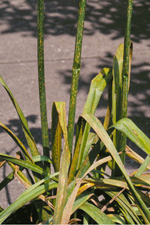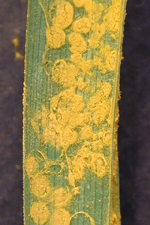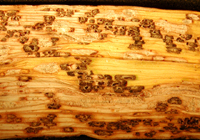
Daylilies are one of the more important perennial plants in the gardens of many American homeowners. They are hardy, flourish while requiring little care, and bloom when many other flowers are not abundant in the garden. In the November 2002 issue of the APS journal Plant Disease, Drs. J. Hernandez, M. Palm and L. Castlebury of the United States Department of Agriculture reported that daylily rust, caused by the fungus Puccinia hemerocallidis, was recently introduced into North America. Although the disease was first reported in Russia in 1880 and was found throughout Asia by 1992, it was first found in Georgia in 2000 and quickly discovered in many states throughout the US and in Costa Rica in 2001.
These authors examined specimens obtained from Alabama, California, Connecticut, Florida, Georgia, Hawaii, Illinois, Indiana, Kentucky, Louisiana, Maryland, Missouri, New Jersey, New York, North Carolina, South Carolina, Tennessee, and Wisconsin to confirm the identity of the fungus. The authors reported that the widespread distribution of daylilies through commerce and among enthusiasts has probably contributed to the rapid spread of this fungus.
 |
|
 |
|
Figure 1 |
|
Figure 2 |
 |
|
Figure 3 |
The rust fungus is serious on daylily and is the only rust fungus found on daylilies in North America (Fig. 1). Symptoms of the disease are typical for rusts. In summer, orange-colored pustules appear on leaves (Fig. 2). These pustules are filled with powdery, orange-colored spores (urediniospores) that are carried by wind to healthy tissues. Near the end of the season, the pustules begin to turn dark in color (Fig. 3). These pustules are filled with another kind of spore (teliospores) of the same fungus that helps the fungus survive the winter.
Homeowner and gardeners should consult with local nurserymen or their County Extension Agent for recommendations to manage and control this disease.
